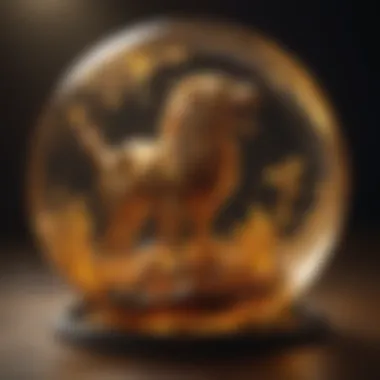Unveiling the Enigmatic World of Priceless Fossils: A Glimpse into Earth's Ancient Past


Rock and Fossil Identification
In the captivating world of paleontology, the identification of rocks and fossils serves as the cornerstone of unraveling the mysteries of our planet's ancient history. Various types of rocks and fossils, ranging from sedimentary to metamorphic, each hold unique clues waiting to be deciphered. Enthusiasts comb through the intricate details etched in these geological specimens, scrutinizing for telltale characteristics that reveal their origin and age.
Understanding the distinct features to look for in fossils and rocks is essential for collectors and researchers alike. Experienced individuals adeptly analyze the texture, color, shape, and composition of these specimens to categorize them accurately. By honing their observational skills and knowledge of geological processes, enthusiasts can discern between fossilized remains of prehistoric creatures and inert mineral formations.
To aid in the meticulous identification process, a plethora of specialized tools are utilized by professionals and hobbyists alike. Magnifying lenses, chisels, brushes, and even chemical tests are deployed to evaluate the authenticity and composition of fossils and rocks. These tools not only assist in distinguishing fossil types but also aid in determining the preservation state and potential value of the specimens.
Introduction
In this article, we embark on a fascinating journey delving into the realm of paleontology and uncovering some of the most valuable fossils ever unearthed. The exploration of these priceless geological treasures not only showcases the beauty of our planet's ancient past but also highlights the significance of these artifacts in scientific research and societal appreciation. Fossils, with their unique stories locked in time, offer a window into past ecosystems, evolution, and geological processes. Through this investigation, we aim to shed light on the allure of these exceptional specimens and their impact on our understanding of Earth's history.
Understanding the Value of Fossils
The Significance of Fossils in Geological Study
Fossils play a paramount role in geological study by providing tangible evidence of ancient life forms and environmental conditions. These preserved remnants offer scientists invaluable insights into past ecosystems, evolutionary processes, and climatic changes. The meticulous analysis of fossils allows researchers to reconstruct past landscapes, understand species interactions, and trace the development of life on Earth. The significance of fossils in geological study lies in their ability to bridge the gap between ancient history and contemporary scientific inquiry, making them a crucial resource for understanding the planet's geological heritage.
Impact of Rare Fossils on Scientific Research
Rare fossils have a profound impact on scientific research, often leading to groundbreaking discoveries and paradigm shifts in paleontology. These exceptional fossils possess unique morphological features, genetic clues, and ecological information that can revolutionize our understanding of prehistoric life. The unearthing of rare fossils not only enriches scientific knowledge but also fuels curiosity and innovation within the paleontological community. By studying these extraordinary specimens, researchers can unlock mysteries of the past, refine evolutionary theories, and expand the boundaries of paleontological exploration.
Factors Influencing the Value of Fossils
Various factors contribute to the value of fossils, including rarity, completeness, preservation quality, scientific significance, and cultural impact. Rare fossils with well-preserved anatomy, exceptional size, or significant historical relevance tend to command higher prices in the market. Additionally, fossils linked to iconic species or pivotal evolutionary events often attract interest from collectors, museums, and researchers alike. The value of a fossil is not merely monetary but also intrinsic, reflecting its scientific, educational, and aesthetic worth in the broader context of natural history.


The Fascination with High-Value Fossils
Aesthetic Appeal and Rarity
The aesthetic appeal and rarity of high-value fossils captivate collectors, enthusiasts, and scientists alike, offering a visual glimpse into the ancient world's diversity and beauty. Fossils with striking colors, intricate patterns, or exceptional preservation often evoke a sense of wonder and admiration, transcending their scientific value to become artful wonders of nature. Whether displayed in museums, private collections, or research institutions, these visually stunning fossils serve as tangible reminders of Earth's prehistoric splendor, igniting a sense of awe and appreciation for the wonders of natural history.
Collector's Market for Premium Fossils
The collector's market for premium fossils thrives on the passion for acquiring rare, extraordinary specimens that showcase exceptional beauty, scientific importance, or historical significance. Collectors, ranging from private individuals to institutional buyers, seek out fossils that embody a combination of rarity, provenance, and aesthetic allure, driving up prices for sought-after pieces. The competitive nature of the fossil market often leads to bidding wars, auctions, and exhibitions that showcase the finest specimens, creating a global community of fossil enthusiasts dedicated to preserving and celebrating Earth's ancient heritage.
Cultural and Historical Value of Ancient Relics
Beyond their scientific and aesthetic appeal, ancient relics hold significant cultural and historical value, serving as touchstones to past civilizations, belief systems, and natural phenomena. Fossils embedded in cultural narratives, folklore, or artistic expressions become more than mere scientific artifacts; they become symbols of human ingenuity, curiosity, and connection to the natural world. By recognizing the cultural and historical importance of ancient relics, we can foster a deeper appreciation for our planet's rich geological history and the enduring legacy of life that has shaped our existence.
Most Expensive Fossil Finds
The section on Most Expensive Fossil Finds within this article serves as a fascinating exploration into the world of paleontology. It sheds light on the significant role that high-value fossils play in enriching our understanding of Earth's history. By delving into the rare and pricey fossils, this section aims to showcase the intricate details of these geological treasures while uncovering the stories they hold from ancient times. The beauty of these fossils goes beyond aesthetic appeal, offering profound insights into prehistoric life forms and environments. Their monetary value reflects not only their rarity but also the scientific and historical significance they bring to the field of paleontology.
Tyrannosaurus Rex Skeletons
Sue - The legendary T.rex discovery:
Sue, the legendary T.rex discovery, stands out as a monumental specimen in the realm of paleontology. Its unearthing has contributed immensely to our comprehension of the Tyrannosaurus Rex species. Sue's massive size and exceptional preservation make it a prime choice for discussion in this article. The detailed structure and well-preserved bones of Sue offer researchers invaluable data on the anatomy and behavior of this ancient predator, enriching our knowledge of prehistoric ecosystems.
Stan - Unveiling the secrets of a fossilized predator:
Stan's discovery has allowed scientists to unveil new secrets about fossilized predators from the past. Its unique features provide a comprehensive look at the physical characteristics and potential hunting techniques of predatory dinosaurs. Stan's inclusion in this article offers readers a deeper understanding of the evolutionary adaptations that shaped these creatures and their relevance in studying ancient ecosystems.


Trike - The triceratops fossil that fetched a fortune:
Trike, the triceratops fossil that fetched a fortune, showcases the commercial and scientific value placed on rare fossils. Its intricate details and well-preserved state have made it a sought-after specimen among collectors and researchers alike. By examining Trike's significance, this article highlights the balance between scientific knowledge and financial investments in the world of paleontology.
Prehistoric Marine Creatures
Ichthyosaur Skeletons - Swimming through ancient seas:
The discovery of Ichthyosaur skeletons provides a glimpse into the underwater world of ancient seas. These fossils reveal the unique anatomy and adaptations of marine reptiles, enhancing our appreciation for prehistoric marine ecosystems. By discussing the importance of Ichthyosaur skeletons, this section underscores the pivotal role of marine creatures in understanding the history of life on Earth.
Megalodon Teeth - Unraveling the mysteries of a giant shark:
Megalodon teeth offer invaluable insights into the mysterious world of prehistoric sharks. These colossal teeth provide clues about the size, diet, and behavior of the Megalodon, a giant predator of ancient oceans. By exploring Megalodon teeth in this article, readers gain a deeper appreciation for the diversity and ferocity of ancient marine life forms.
Amber Inclusions - Fossilized snapshots of marine life:
Amber inclusions present fossilized snapshots of marine life, capturing moments frozen in time. These intricate specimens preserve delicate details of ancient organisms, offering a window into past marine ecosystems. By examining the significance of amber inclusions, this article showcases the exceptional preservation quality of amber and its ability to reveal the hidden beauty of marine life.
Ancient Plant Specimens
Ginkgo Petrified Wood - A glimpse into prehistoric forests:
The discovery of Ginkgo petrified wood provides a rare glimpse into prehistoric forests and the plant life that inhabited them. These fossilized specimens offer valuable information about ancient vegetation, growth patterns, and environmental conditions. By discussing Ginkgo petrified wood, this section highlights the importance of plant fossils in reconstructing terrestrial landscapes of the past.
Rare Fern Fossils - Preserving ancient botanical wonders:
Rare fern fossils are instrumental in preserving the botanical wonders of bygone eras. These fossils offer detailed insights into ancient fern species, their morphology, and evolutionary significance. By delving into rare fern fossils, this article showcases the diverse plant life that thrived in ancient environments and the importance of botanical fossils in understanding plant evolution.


Cycad Fossilized Seeds - Seeds of ancient plant evolution:
Cycad fossilized seeds provide a unique perspective on ancient plant evolution and reproductive strategies. These well-preserved seeds offer crucial information about cycads and their role in shaping prehistoric ecosystems. By exploring cycad fossilized seeds, readers are introduced to the intricate processes of plant reproduction and the resilience of ancient plant species.
Exceptional Insect Fossils
Burmese Amber Insects - Trapped in time for millions of years:
Burmese amber insects offer a captivating look at insect life forms preserved for millions of years. These specimens provide unparalleled insights into ancient insect biodiversity, behaviors, and adaptations. By examining Burmese amber insects, this article highlights the intricate details captured in amber and their scientific value in unraveling the mysteries of prehistoric entomology.
Baltic Amber Beetles - Insights into ancient insect biodiversity:
Baltic amber beetles present a wealth of information on ancient insect biodiversity and ecological interactions. These well-preserved beetles offer valuable data on past ecosystems, species distribution, and evolutionary adaptations. By exploring Baltic amber beetles, readers gain a deeper understanding of the interconnectedness of ancient insect species and their role in ecological stability.
Insect Inclusions - Microscopic treasures preserved in amber:
Insect inclusions encapsulate microscopic treasures preserved in amber, showcasing the intricate details of ancient insects. These fragile specimens provide a unique perspective on prehistoric insect morphology, behaviors, and ecological niches. By discussing insect inclusions, this article highlights the exceptional preservation quality of amber and its ability to capture the essence of ancient insect life.
Conclusion
Appreciating the Value of Fossils
The Enduring Legacy of Fossil Discoveries
The enduring legacy of fossil discoveries stands as a cornerstone in the tapestry of paleontological research. These fossils, frozen in time, offer a window into ancient worlds, allowing us to unravel the mysteries of evolution and existence. Their enduring nature preserves not just the physical remains but the very essence of lifeforms long gone. In this article, the focus on the enduring legacy sheds light on the timeless relevance of fossils, serving as tangible connections to our past and invaluable resources for understanding Earth's evolution.
Implications for Paleontological Research
Delving into the implications for paleontological research opens doors to boundless opportunities for scientific exploration. By examining fossils, researchers can decipher evolutionary patterns, ecological dynamics, and the adaptations of extinct species that once roamed the Earth. The implications showcased in this article underscore the pivotal role of fossils in shaping our understanding of prehistoric life, offering insights that transcend time and space to enrich our knowledge of the natural world.
Celebrating the Beauty and Historical Significance of Fossils
The beauty and historical significance of fossils evoke a sense of wonder and appreciation for the wonders of our planet's history. Each fossil tells a unique story, painting a vivid picture of bygone eras and ancient ecosystems. In this article, the celebration of fossil beauty and historical value not only highlights the aesthetic appeal of these geological treasures but also pays homage to the intricate web of life that has shaped our world. It serves as a reminder of the intricate balance between preservation and discovery, inviting us to marvel at the beauty and historical importance encapsulated in these priceless fossils.







